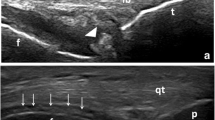Abstract:
The aim of the study was to investigate the frequency of development of local calcium pyrophosphate (CPPD) crystal deposition in patients with knee OA initially found negative for these crystals, as well as to discover whether prognostic indicators for this subset of patients can be found. A clinical follow-up of records of outpatients with idiopathic knee OA was established. An anteroposterior plain radiography of the knee joints was made initially and at the end of the observation period. The follow-up period needed to be more than 1 year. Patients were divided into two groups. The first included patients with knee OA who did not develop intra-articular CPPD crystal deposition during the observation period (OA group). The second included those patients whose X-rays or synovial fluid (SF) analysis in the follow-up showed these crystal deposits to be present (OA + CPPD group). There were 59 patients (42 women, 17 men) who met the selection criteria. During the observation period (8.1 ± 7.4 years in the OA group, 10.4 ± 6 years in the OA + CPPD group), intra-articular CPPD deposits were observed in 15 patients (25%): 10 on the X-rays, eight in the SF and three in both examinations. Age at diagnosis of OA and incidence of obesity were similar in both groups. There was a trend (P= 0.21) towards men developing intra-articular CPPD crystal deposits more frequently than women. OA in only one knee joint was significantly more frequent in the group with CPPD (P<0.01). Of those with CPPD deposits 40% required surgery at the end of the observation period, compared to 27.2% of those without deposits (P= 0.27). The waiting period before knee surgery was shorter in the OA + CPPD group but the difference was not statistically significant. In conclusion, local CPPD crystal deposition was observed in 25% of cases during the evolution of knee OA. No predictive factors were found. OA of the knee could, per se, favour the development of CPPD deposits. The occurrence of intra-articular CPPD deposits seemed to be related to a more rapid and severe evolution of OA of the knee.
Similar content being viewed by others
Author information
Authors and Affiliations
Additional information
Received: 25 October 2000 / Accepted: 18 June 2001
Rights and permissions
About this article
Cite this article
Reuge, L., Van Linthoudt, D. & Gerster, JC. Local Deposition of Calcium Pyrophosphate Crystals in Evolution of Knee Osteoarthritis. Clin Rheumatol 20, 428–431 (2001). https://doi.org/10.1007/PL00011212
Published:
Issue Date:
DOI: https://doi.org/10.1007/PL00011212




